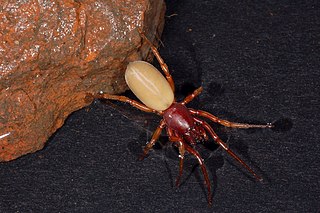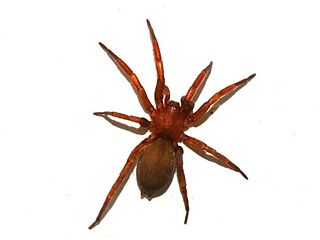
Dysderidae, also known as woodlouse hunters, sowbug-eating spiders, and cell spiders, is a family of araneomorph spiders first described by Carl Ludwig Koch in 1837. They are found primarily in Eurasia, extending into North Africa with very few species occurring in South America. Dysdera crocata is introduced into many regions of the world.

Tegenaria is a genus of fast-running funnel weavers that occupy much of the Northern Hemisphere except for Japan and Indonesia. It was first described by Pierre André Latreille in 1804, though many of its species have been moved elsewhere. The majority of these were moved to Eratigena, including the giant house spider and the hobo spider.

Zodarion is a genus of ant-eating spiders from the family Zodariidae. 169 species from Eurasia, North Africa and North America have been described as of November 2022.

Dysdera is a genus of woodlouse hunting spiders that was first described by Pierre André Latreille in 1804. They originated from Central Asia to Central Europe.

Amaurobius is a genus of tangled nest spiders that was first described by Carl Ludwig Koch in 1837.

Enoplognatha is a genus of comb-footed spiders first described by P. Pavesi in 1880. They were characterized by both a large colulus and a subspherical abdomen, with males usually have enlarged chelicerae. It is considered a senior synonym of Symopagia.

Histopona is a genus of funnel weavers first described as a sub-genus of Hadites by Tamerlan Thorell in 1870. It was elevated to genus by Brignoli in 1972.
Dasumia is a genus of woodlouse hunting spiders that was first described by Tamerlan Thorell in 1875.

Lepthyphantes is a genus of dwarf spiders that was first described by Anton Menge in 1866.

Lathys is a genus of cribellate araneomorph spiders in the family Dictynidae, and was first described by Eugène Simon in 1884. It is a replacement name for "Lethia" Menge, 1869 because that name was already in use as a synonym for a genus of moths.
Hygrocrates is a genus of woodlouse hunting spiders that was first described by Christa L. Deeleman-Reinhold & P. R. Deeleman in 1988.

Brachythele is a genus of spiders in the family Nemesiidae. It was first described in 1871 by Ausserer. As of 2022, it contains 10 species from eastern Europe.

Raveniola is a genus of spiders in the family Nemesiidae, first described in 1987 by Zonstein.

Haplodrassus is a genus of ground spiders that was first described by R. V. Chamberlin in 1922. They range from 3 to 10 millimetres. H. signifer is the most widespread species, found across North America except for Alaska and northern Canada.

Araeoncus is a genus of dwarf spiders that was first described by Eugène Louis Simon in 1884. They closely resemble members of Diplocephalus; both genera have a uniquely shaped of the cephalothorax and a species-specific modification of the tibial apophysis of the pedipalp.

Centromerus is a genus of dwarf spiders that was first described by David B. Hirst in 1886.















